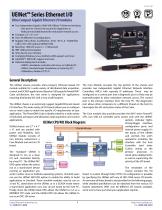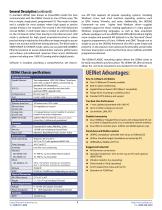
Catalog excerpts

Ultra Compact Gigabit Ethernet I/O modules UEINet™ Series Ethernet I/O TEST VERIFIED Two independent Gigabit (1000/100/10Base-T) Ethernet Interfaces - One port for Control, the second for diagnostics or - Both ports bonded/teamed for redundant network access Compact: 2.7" x 4" x 4.1" Over 70 different I/O configurations Rugged: 100 g shock, 5 g Vibration, -40 to +50 °C, 0 - 70,000 feet (-40 to 70°C with optional UEINet-FAN) Real-time: 1000 I/O scans in < 1 millisecond IEEE 1588 synchronization Inter-device sync interface Complete Windows, Linux, VxWorks, QNX support and more LabVIEW TM, MATLAB® support and more Optional deployments include: - UEIPAC, standalone controller with Linux or VxWorks OS - UEISim, Simulink target (standalone or hosted by PC) - UEIModbus, Modbus TCP I/O General Description: The UEINet chassis provides ultra-compact, Ethernet based I/O module suitable for a wide variety of distributed data acquistion, control, and SCADA applications. Based on UEI’s popular PowerDNA® Cube architecture, the new series is designed for applications requiring distributed I/O with a very small footprint. The UEINet chassis is an extremely rugged, Gigabit Ethernet-based I/O interface. The wide variety of I/O boards allows you to configure one or more cubes to match the specific I/O requirements of your application. The PowerDNA Cube is ideally suited for a wide variety of industrial, aerospace and laboratory data acquisition and control applications. UEINet chassis are 2.7" x 4.1" x 4", and are packed with power and flexibility. Each UEINet module consists of two primary subsections: a Core Module and and an I/O board. The Core module also provides provides the 8347 series PowerPC CPU, two USB 2.0 controller ports (active only with the UEIPAC option), indicator lights, UEINet CPU/NIC Block Diagram: timing/trigger interface, configuration ports and 32-bit 66-MHz bus internal power supply. It’s the brains of the UEINet and controls the unit’s RTC operations including the FLASH interface with the host 1000-BASE-T MII Controller (and other MAC PHY RJ-45 Cubes), acting as the DDR2 FPGA MII primary processor in MAC PHY RJ-45 PPC 8347 stand alone deployments, as well as supervising the Power In activity of the I/O board. The “standard” UEINet is designed to run as a slave I/O unit controlled directly by a host PC. The UEINet PAC DC/DC UPG option allows the unit to 9-36V DC Input run as a stand-alone device Power Out running an application you write in either Linux or VxWorks operating systems. Simulink users can use the UEINet SIM UPG option to enable the ability to build applications in Simulink. These simulink modules may be run on a host PC, stand-alone on the UEINet, or in a SCADA mode where a stand-alone application runs, but can be tuned by the host PC. Finally, there the UEINet Mod UPG allows the UEINet to run as a MODBUS TCP node, and the UEINet OPC-UA allows the UEINet to run as an OPC-UA server. United Electronic Industries, Inc. Tel: (508) 921-4600 The Core Module occupies the top portion of the chassis and provides two independent Gigabit Ethernet Network Interface Controllers (NICs) with separate IP addresses. These may be configured as a control port and a diagnostic port or they may be teamed/bonded to allow redundant network access. The control port is the primary interface from the host PC. The diagnostics port allows other computers (or a different thread on the host) to interrogate the I/O and system status of the Cube. The remainder of the chassis contains the I/O board. A custom (though fully COTS) I/O configuration is possible by specifying the UEINet with any of UEI’s DNA-series I/O boards. An overview of these board is also provided on the following pages, while detailed specifiations can be obtained from the various I/O boards’ datasheets. With over 60 different I/O boards available, we’re sure to have just what your application requires.
Open the catalog to page 1
General Description (continued): In standard UEINet (also known as PowerDNA mode) the host communicates with the UEINet chassis in one of three ways. The first is simple, single point, programmed I/O. This mode is simple and is suitable for most systems where high speed or precise sample timing is not required. The second is the ACB (Advanced Circular Buffer). In ACB mode data is written to and from buffers on the I/O boards rather than directly to the Ethernet port. ACB mode is preferred for high speed acquisition/control or where precise timing is required as the buffers are large enough...
Open the catalog to page 2
UEINet Interface description: A Network Connectors Dual independent Gigabit (1000/100/10Base-T) Ethernet ports, each with a unique IP address. Two USB 2.0 controller ports. Controller port suitable for connection to external peripheral devices. Slave port suitable for connecting the cube to a host computer. The USB ports are not usable in PowerDNA mode. These two green lights give a visual indication of the status of each I/O layer. Secure Digital (SD) Card slot for onboard data storage. It also stores linux embedded programs deployed on the cube using the embedded toolkit. Supports FAT12,...
Open the catalog to page 3




